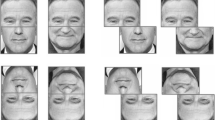A cognitive set model to emotional facial expressions was used in healthy adult humans to study evoked synchronization/desynchronization reactions of cortical theta and alpha activity to images of faces during increased loading on working memory (with an additional task consisting of recognizing verbal stimuli). A correlation was seen between behavioral (increased set inertia) and electrophysiological (decreased evoked theta-rhythm synchronization) experimental data. We propose the hypothesis that increases in tonic prestimulus activity of theta potentials during the prestimulus period and suppression of phasic corticohippocampal system activation reactions are among the neural mechanisms decreasing the plasticity of the cognitive function of recognizing emotional facial expressions in humans in conditions of increased loading on working memory. The question of the reciprocal relationships between the two functional systems integrating brain activity – the corticohippocampal and the frontothalamic – in the process of recognizing emotional facial expressions is discussed.
Similar content being viewed by others
References
M. K. Kozlov, “Assessment of the significance of the variance characteristics of pre- and poststimulus EEG curves using the chisquared test,” Zh. Vyssh. Nerv. Deyat., 59, No. 2, 281–290 (2009).
E. A. Kostandov, N. S. Kurova, E. A. Cheremushkin, and I. A. Yakovenko, “The role of working memory in forming visual sets,” Zh. Vyssh. Nerv. Deyat., 52, No. 2, 149–155 (2002).
E. A. Kostandov, N. S. Kurova, E. A. Cheremushkin, and I. A. Yakovenko, “Changes in cortical electrical activity on formation of a set in conditions of increased loading on working memory,” Zh. Vyssh. Nerv. Deyat., 54, No. 4, 448–454 (2004).
E. A. Kostandov, N. S. Kurova, E. A. Cheremushkin, I. A. Yakovenko, and M. L. Ashkinazi, “The role of the context of cognitive activity in the conservatism of unconscious visual sets,” Zh. Vyssh. Nerv. Deyat., 55, No. 5, 633–638 (2005).
E. A. Kostandov, N. S. Kurova, E. A. Cheremushkin, N. E. Petrenko, M. L. Ashkinazi, and I. A. Yakovenko, “Relationship between the plasticity of a set to an emotional facial expression and the loading on working memory,” Zh. Vyssh. Nerv. Deyat., 58, No. 1, 42–50 (2008).
E. A. Kostandov and E. A. Cheremushkin, “Dependence of the spatial synchronization of prestimulus cortical electrical activity on the loading on working memory during recognition of an emotional facial expression,” Zh. Vyssh. Nerv. Deyat., 60, No. 2, 166–174 (2010).
E. A. Kostandov, E. A. Cheremushkin, and M. K. Kozlov, “Evoked synchronization/desynchronization of cortical electrical activity in response to facial stimuli during formation of a set to an emotionally negative expression,” Zh. Vyssh. Nerv. Deyat., 59, No. 1, 22–32 (2009).
N. S. Kurova, E. A. Cheremushkin, and M. L. Ashkinazi, “EEG spectral characteristics at different stages of an unconscious visual set at two levels of motivation,” Zh. Vyssh. Nerv. Deyat., 52, No. 4, 406–416 (2002).
N. S. Kurova, E. A. Cheremushkin, and M. L. Ashkinazi, “EEG coherence during realization of an unconscious visual set in conditions of increased motivation of subjects,” Zh. Vyssh. Nerv. Deyat., 53, No. 6, 705–711 (2003).
D. N. Uznadze, Experimental Basis of Set Psychology. Experimental studies in Set Psychology [in Russian], Georgian SSR Academy of Sciences Press (1958), pp. 5–126.
M. Bastiansen and P. Hagoort, “Event-induced theta responses as a window on the dynamics of memory,” Cortex, 39, 967–992 (2003).
J. B. Caplan, J. R. Madsen, A. Schulze-Bonhage, R. Aschenbrenner-Scheibe, E. L. Newman, and M. L. Kahana, “Human theta-oscillations related to sensorimotor integration and spatial learning,” J. Neurosci., 23, No. 11, 4726–4736 (2003).
M. D’Esposito, J. A. Detre, D. C. Alsop, R. K. Shin, S. Atlas, and M. Grossman, “The neural basis of the central executive systems of working memory,” Nature, 378, 279–281 (1995).
P. Ekman and W. V. Friesen, Pictures of Facial Affect, Consultants Psychol. Press, Palo Alto (1976).
A. Gevins and E. Smith, “Neurophysiological measures of working memory and individual differences in cognitive ability and cognitive style,” Cereb. Cortex, 10, No. 9, 829–839 (2000).
P. S. Goldman-Rakic, “Space and time in the mental universe,” Nature, 386, 559–560 (1997).
S. Guderian and E. Duzel, “Induced theta oscillations mediate largescale synchrony with mediotemporal areas during recollection in humans,” Hippocampus, 15, No. 7, 901–912 (2005).
M. E. Hasselmo and H. Eichenbaum, “Hippocampus mechanisms for the context-dependent retrieval of episodes,” Neural Networks, 18, 1172–1190 (2005).
I. G. Kirk and J. C. Mackay, “The role of theta-range oscillations in synchronizing and integrating activity in distributed mnemonic networks,” Cortex, 39, 993–1008 (2003).
W. Klimesch, “EEG alpha and theta oscillations reflect cognitive and memory performance: a review and analysis,” Brain Res. Rev., 29, 169–195 (1999).
W. Klimesch, P. Sauseng, and S. Hanslmayr, “EEG alpha oscillation: The inhibition-timing hypothesis,” Brain Res. Rev., 53, 63–88 (2007).
W. Klimesch, B. Schack, and P. Sauseng, “The functional significance of theta and upper alpha oscillations,” Exp. Psychol., 52, No. 2, 99–108 (2005).
G. Rainer,W. F. Asaad, and E. K. Miller, “Memory fields of neurons in the primate prefrontal cortex,” Proc. Natl. Acad. Sci. USA, 95, 15008–15013 (1998).
J. Rissman, A. Gazzaley, and M. D’Esposito, “Dynamic adjustments in prefrontal, hippocampal, and inferior temporal interactions with increasing visual working memory load,” Cereb. Cortex, 18, No. 7, 1618–1629 (2008).
H. J. Yoon, N. H. Joshua, and M. D’Esposito, “Segregation of function in the lateral prefrontal cortex during visual object working memory,” Brain Res., 1184, 217–225 (2007).
Author information
Authors and Affiliations
Corresponding author
Additional information
Translated from Zhurnal Vysshei Nervnoi Deyatel’nosti imeni I. P. Pavlova, Vol. 61, No. 1, pp. 35–46, January–February, 2011.
Rights and permissions
About this article
Cite this article
Kostandov, E.A., Cheremushkin, E.A. Synchronization/Desynchronization of Cortical Electrical Activity in the Theta and Alpha Ranges Evoked by Facial Images during Increased Loading on Working Memory. Neurosci Behav Physi 42, 495–504 (2012). https://doi.org/10.1007/s11055-012-9591-1
Received:
Accepted:
Published:
Issue Date:
DOI: https://doi.org/10.1007/s11055-012-9591-1




